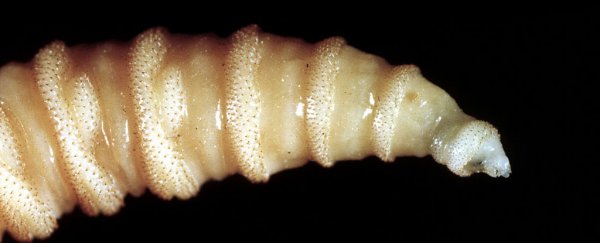Florida is on high alert after the return of an invasive, flesh-eating parasite that has killed more than 100 deer since July.
The re-emergence of the New World screwworm, which was thought to have been eradicated from the US decades ago, has resulted in an agricultural state of emergency being declared in Monroe County, Florida, as authorities try to contain the outbreak.
The screwworm, so named because its ridges resemble the spiral shape of a screw, is the larvae (maggot) of the Cochliomyia hominivorax fly.
When this species matures, it looks much like a common housefly, but its larvae are especially dangerous.
The larvae infect warm-blooded animals, burrowing into open wounds and feeding on living flesh. People are also at risk from the parasite, although none have been infected in the recent outbreak.
The parasite, which hadn't been seen in Florida for 50 years, was the target of a long-fought eradication campaign starting in the 1930s, which was ultimately deemed successful in 1966.
Since then, local authorities have maintained a biological control called the sterile insect technique, to prevent the screwworm from re-entering the US from South and Central America.
This process involves releasing infertile male flies that have been sterilised by radiation into the wild. Female flies only mate once in their lives, and when they mate with these infertile males, no offspring result, ensuring that the screwworm is bred out of existence in infested areas.
But despite efforts to protect the US from the parasite with ongoing sterile fly barriers at the Darién Gap between Panama and Colombia, the screwworm got back in somehow, turning up in Monroe County in July, where it was reported in wild deer.
The deer species infested, called Key deer, only lives in Florida, and is endangered, with less than 1,000 remaining in the National Key Deer Refuge, run by the US Fish and Wildlife Service.
But as if the Key deer didn't have enough problems, the screwworm infestation has seen 132 of these animals killed since July – about 15 percent of the whole population.
"We had no idea what this thing was," ranger Kristie Killam told Frances Robles at The New York Times.
"There was a few here and there in July and August, but it was September, when the rut started, that we started scratching our heads and saying, 'This is a little bit out of the ordinary'," she added. "It looks like a horribly infected wound, an infected wound that never got treated, infected with mushy maggots."
Initially mistaking the parasite wounds for regular flesh wounds caused by deer fighting, the rangers weren't aware of the deadly pest in their midst, which also infected two cats, a dog, and a pig.
But lab tests run in September confirmed the outbreak was indeed screwworms, with Florida declaring an agricultural state of emergency in October.
The good news is that protection measures to stem the outbreak – including sterile flies, a quarantine area, and anti-parasitic medications – appear to be working.
The US Fish & Wildlife Service announced last week that the deer population seems to have stabilised at 875, with no new deaths in a week – the first time this has happened since the outbreak began.
While any warm-blooded animals are susceptible to screwworms, the real threat is to agriculture – although there's also a rare but potential risk to humans.
Since the eradication in the 1960s, only sporadic instances of screwworm infections in the US have occurred – usually isolated cases of infected travellers returning from other countries.
One of these cases involved a 12-year-old girl who had travelled with her family to Colombia, then complained of extreme pain in her scalp upon returning home to Connecticut.
Doctors eventually removed 142 screwworm larvae from her head, resorting to using "bacon therapy" – luring the parasites out with pieces of meat placed over the worms.
Efforts to contain the latest outbreak are expected to continue well into 2017, and hopefully we'll have new information soon to show us that infection counts are dropping – as this nightmarish parasite is the last thing the world needs right now.
